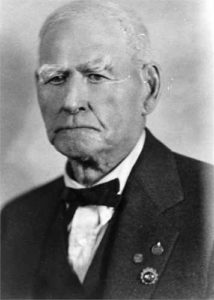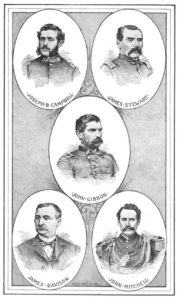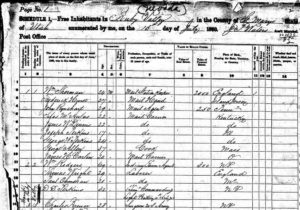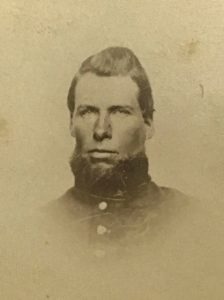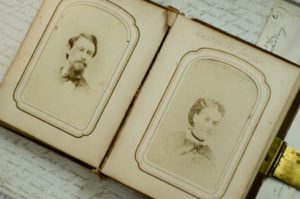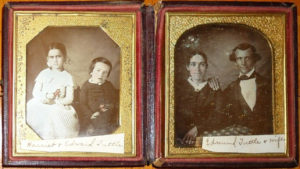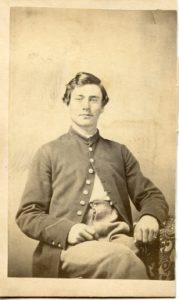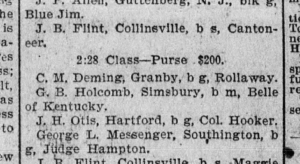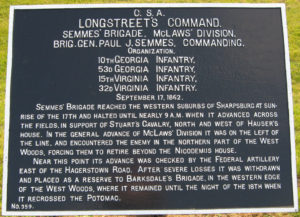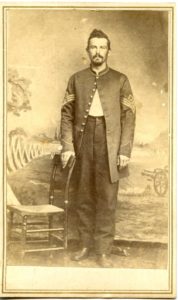Horace Ripley (1938)
14 March 2022
Horace Ripley enlisted at age 19 in 1861 in the 7th Wisconsin Infantry and was detailed to Battery B of the 4th US Artillery less than a week before the battle of Antietam, on 12 September 1862. He learned his new job under fire on the 17th, from Sun Prairie, WI neighbor Elbridge E Packard of the 2nd Wisconsin, an “old hand” who’d been with the battery since November 1861.
The clip at the top is from a local history called Nevada and Vernon County’s Heritage (2005), shared online by Lois Ripley Chavez. His portrait photograph – probably also taken about 1938 – was contributed to the FamilySearch database by Betsy Jill Chesire.
The Battle Leaders of the Battery.
13 March 2022
From the frontpiece of Augustus C Buell’s The Cannoneer: Recollections of Service in the Army of the Potomac (1890), here are some of the officers of Battery B, 4th United States Artillery before and during the war. Etchings after photographs.
Captain Campbell commanded the battery at Antietam until wounded, succeeded by Lieutenant Stewart. Brigadier General Gibbon, a career Regular Artillery officer, was Captain of Battery B at the start of the war; he led the Brigade and helped man a gun of Battery B at Antietam. Lieutenant Davison of the 3rd US Artillery joined the battery after Antietam and commanded a “half-battery” of “B” at Gettysburg until he was wounded and replaced by then-Lieutenant Mitchell. Mitchell was First Sergeant of the Battery at Antietam and cited for bravery there. He is pictured here in his post-war uniform as a Captain in the 43rd (later 1st) US Infantry.
Augustus Caesar Buell (1847-1904) is now generally known as a “fraud historian” – particularly because of his biographies: Paul Jones, Founder of the American Navy (1900), Sir William Johnson (1903), William Penn as the Founder of Two Commonwealths (1904), and History of Andrew Jackson, Pioneer, Patriot, Soldier, Politician, President (1904) – all apparently at least plagiarized if not entirely made-up.
He wrote much of Cannoneer as if he was an eyewitness to it all, when he hadn’t actually enlisted in the 20th New York Cavalry until August 1863 and was (probably) detailed to the battery some time later. Although it must be viewed skeptically, the book is an excellent source of detailed information about Battery B/4th US Artillery.
It owes its value to the many soldiers and officers of the battery who contributed to its content, notably Captain Stewart, Sergeant C.A. Santmyer, and Private B.H. Stillman, who had been detailed from the 7th Wisconsin Infantry.
Bugler John Cook (c. 1862)
11 March 2022
John Cook was not quite 14 when he enlisted as Bugler of Battery B, 4th United States Artillery in June 1861. You probably recognize his name from his heroism at Antietam in September 1862, for which he was much later awarded the Medal of Honor.
Here he is in a widely reproduced image probably taken soon after his enlistment. Thanks to the Adjutant General’s Corps Regimental Association (AGCRA) for putting that online.
Battery B, 4th US Artillery in July 1860
10 March 2022
In 1860, the companies [of the 4th United States Artillery] in Utah were kept busy protecting the parties of emigrants going West, and keeping open the mail routes. Light Battery B, operating as cavalry, marched during that summer 2000 miles over a barren and desert country, and though the Indians were continually hostile, the roads were kept open. The battery had a successful fight against 200 Indians at Eagan’s Canyon, August 11, 1860, losing three men wounded (one mortally).
From May to October 1860 Battery B was based at the small Pony Express station located at Station Spring at the southern end of Ruby Valley in western Utah Territory (now Nevada). 32 year old First Lieutenant D.D. (Delavan Duane) Perkins, USMA ’49 was in command; Lieutenant Stephen H Weed USMA ’54 and Surgeon Charles Brewer (Assistant Surgeon CSA 1861-65) were the other officers.
On 15 and 16 July 1860 US Census enumerator J.P. Waters identified 105 Americans there, but did not include the band of Shoshone who lived nearby. His three page [ page 1 | page 2 | page 3 ] listing of the residents is a great reference for students of the Battery.
Among the 70 soldiers listed in Ruby Valley that summer at least 17 were also in action with Battery B just over two years later at Antietam, including then-Sergeant James Stewart, who commanded the Battery at Antietam after Captain Campbell was wounded, and Private Richard L Tea, who was slightly wounded at Antietam, was awarded the Medal of Honor in 1876 for action against the Cheyenne in Kansas the year before, and retired from the Army in 1888 after 30 years in uniform.
Others of the Battery in that 1860 Census list known to be at Antietam in 1862:
William West (WIA Antietam)
John Mitchell
Andrew J Ames (WIA Antietam)
Joseph Brownlee (WIA Antietam)
John Brown (KIA Antietam)
James Cahoo
Frederick A Chapin
Henry P Lyons (KIA Antietam)
William Kelly
Joseph Herzog (MWIA Antietam)
Andrew McBride
John Wilsee/Wilsey (WIA Antietam)
Robert Moore (WIA Antietam)
William Kelly
William Moffitt (WIA Antietam)
_______________
The quote at the top is from the US Army history of the 4th Regiment of Artillery, online thanks to the Center of Military History.
The census pages are from 1860 United States Federal Census, Population, Schedule 1. NARA microfilm publication M653 (1,438 rolls). Washington, D.C.: National Archives and Records Administration. The Ruby Valley, St. Mary’s, Utah Territory set are on roll M653_1314, Pages 1-3. I found these page images online thanks to FamilySearch.
The photograph of the Battery’s battlefield tablet at Antietam was taken by Craig Swain for the HMDB.
Pvt George W Cooley (c. 1861)
7 March 2022
This impressive photograph of George W Cooley, Company F, 7th Wisconsin Infantry is from the massive collection of Dennis Skalstad, who kindly shared it online on Cooley’s cemetery memorial page. Private Cooley was killed at Turner’s Gap on South Mountain in Maryland on 14 September 1862.
Charles L Taylor and Harriet W Tuttle (1862, c. 1848)
28 February 2022
Bristol, CT bookkeeper Charles Lyman Taylor enlisted as a Sergeant in the 16th Connecticut Infantry on 29 July 1862 and married Harriet Wenslow Tuttle (1840-1916) about 26 August. There was probably no honeymoon, as he and his regiment left for the war immediately after.
I’d guess these photographs were taken on the occasion of that wedding.
Below are Harriet and her family some years earlier. Harriet and younger brother Edward Hubbard Tuttle (1842-1868); mother Betsey Hubbard (1814-1888) and father Edmund Tuttle (1814-1886), a mechanic and deacon in Meriden, CT. Excellent images, both.
——————-
The wedding pictures accompanied a very large collection of the couple’s letters sold at auction by Swann Galleries in 2016. Family genealogist Charles J Christenson shared that pair of Tuttle photographs to the FamilySearch database.
Pvt Gavette B Holcomb (c. 1862)
28 February 2022
In an 1863 letter home to his parents Private Gavette Burt Holcomb of the 16th Connecticut Infantry wrote
We are raising the flag to day and well we might for one year agoe was the day that we received a warm reception from those grea [gray]backs, such a one as, I never forget, that day was 17 Sept 1862. That day many of our brave Soldiers died.
He was a farmer in his hometown of Simsbury, CT for the rest of his life, and was for many years on the school board there. And he apparently owned one of the faster horses in the area, a mare named Belle of Kentucky.
The fairgrounds at Cherry Park in Avon, CT hosted a regional fair every September from 1883 to 1911, complete with horse racing on a dirt oval about 1/2 mile long. There was auto racing there in the 1930’s and 40s and a suburban housing development took over in about 1960.
Gavett is about 17 years old in that photograph, from Jim Silliman out of his collection. His 1863 letter is in the collection of the Simsbury Historical Society. The news clippings are from the New Haven Morning Courier and Journal of 6 September 1895, online from the Library of Congress.
Old Man Guest
21 February 2022
Benjamin Franklin Guest was at least 55 years old when he was killed in the battle at Sharpsburg in September 1862; a Private in Company F, 53rd Georgia Infantry.
His is indeed a hard-luck story.
Family history, supported by the US Census, says he lost his Madison County, GA farm and his family due to his drinking, and by 1860 was living alone, an overseer on a farm in Griffin, Spalding County, GA. In May 1862 he signed-up as a substitute for one R.A. McDonald (possibly Robert Alexander McDonald, 1831-1904) of Company F.
The family story says he was killed by a “sniper” on 16 September at Sharpsburg, which is somewhat unlikely, as the 53rd Georgia and the rest of the Brigade arrived at Sharpsburg from Harpers Ferry at sunrise on the 17th. His very brief military record says he was killed on 17 September.
I don’t have a birth year for every soldier killed at Sharpsburg, but among those I do have, Guest is the 2nd oldest. The oldest being Private Adam Burkel of the 11th Pennsylvania Infantry – who was about 57 years old at Antietam.
———————–
The photograph of Semmes’ Brigade’s battlefield tablet was taken by Craig Swain for the Historical Marker Database (HMDB).
First Sergeant Roland LeVaughn (c. 1863)
20 February 2022
Another excellent photograph from Jim Silliman’s album.
He’s Roland LeVaughn, a mechanic from Rocky Hill, CT. He enlisted in Company C of the 16th Connecticut as a Private, was promoted to Corporal in Maryland in September 1862, and was appointed First Sergeant of Company A in December 1863, which must have been about when this picture was taken.
Roland and his brother William (First Sergeant, Company C) were both prisoners of war at Andersonville, GA. William died there on 7 September 1864 and Roland died in a prison in Charleston, SC about two weeks later.
First Sergeant Ezra T Burgess (c. 1862)
19 February 2022
Here’s another soldier of the 16th Connecticut from the collection of Jim Silliman: Ezra Thomas Burgess of Company E. He was promoted to First Sergeant on the field at Antietam – his new stripes seen here – and survived imprisonment at Andersonville.

